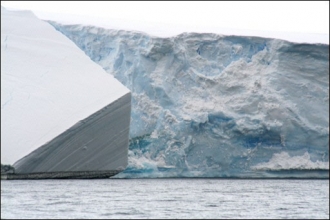Home > Giant Antarctic Wilkins Ice Shelf Collapses! (2008.03.25 + VIDEO)
Giant Antarctic Wilkins Ice Shelf Collapses! (2008.03.25 + VIDEO)
by Open-Publishing - Monday 8 December 2008A vast hunk of floating ice has broken away from the Antarctic peninsula, threatening the collapse of a much larger ice shelf behind it, in a development that has shocked climate scientists.

(ajoût)
Satellite images show that about 160 square miles of the Wilkins ice shelf has been lost since the end of February, leaving the ice interior now "hanging by a thread".
The collapsing shelf suggests that climate change could be forcing change much more quickly than scientists had predicted.
"The ice shelf is hanging by a thread," said Professor David Vaughan of the British Antarctic Survey (BAS). "We’ll know in the next few days or weeks what its fate will be."
The Wilkins shelf covers an area of 5,600 square miles (14,500 sq km). It is now protected by just a thin thread of ice between two islands.
Vaughan was a member of the team that predicted in 1993 that global warming could cause the Wilkins shelf to collapse within 30 years.
The shedding of peripheral floating ice shelves has occurred elsewhere on the peninsula, allowing inland ice to move towards the sea and cause rising sea levels.
Some areas of the frozen continent have been cooler in recent years, and have added ice through accumulated snowfall. This year, the thin floating layer of sea ice that forms each austral winter and fades in summer has in fact been larger than usual, in contrast to the Arctic.
But in other parts — such as the West Antarctic ice sheet — ice is being lost to the sea.
The darker area shows the chunk that has broken away. Picture: Nasa
Climate scientists around Antarctica were taken by surprise by the new find. "Wilkins is the largest ice shelf on the Antarctic peninsula yet to be threatened," Vaughan said.
"I didn’t expect to see things happen this quickly. We predicted it would happen, but it’s happened twice as fast as we predicted."
The retreat of the shelf was first spotted from satellite data by Ted Scambos, a glaciologist at the University of Colorado.
He alerted the BAS, which sent an aircraft to assess the extent of the damage.
Jim Elliott, who filmed part of the breakup, said: "It was awesome. We flew along the main crack and observed the sheer scale of movement from the breakage. Big chunks of ice, the size of small houses, look as though they’ve been thrown around like rubble — it’s like an explosion."
The Antarctic peninsula, which stretches north from the frozen continent towards South America, has experienced unprecedented warming over the past 50 years.
Six other ice shelves have already been lost entirely — the Prince Gustav Channel, Larsen Inlet, Larsen B, Wordie, Muller and Jones shelves.
But the Wilkins shelf is farther south than other ice that has retreated, so should be better protected by colder temperatures.
Vaughan said: "It’s bigger than any ice shelf we’ve seen retreating before, and in the long term it could be a taste of other things to come. It is another indication of the impact that climate change is having on the region
http://www.guardian.co.uk/environment/2008/mar/26/poles.antarctica
http://internationalnews.over-blog.com/article-25587098.html




